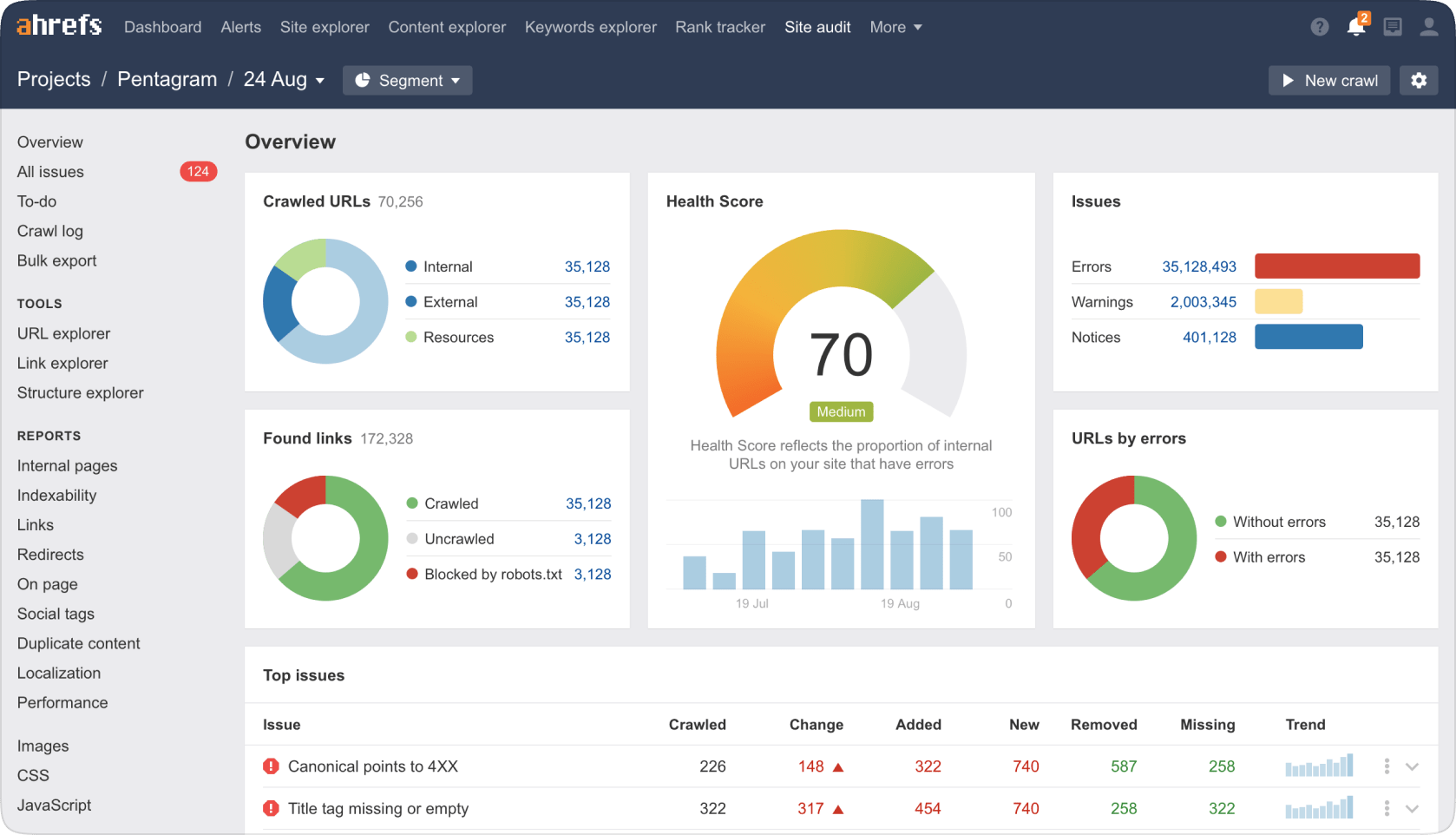
When it comes to search engine optimization, monitoring is a crucial step that many people overlook. It's easy to get caught up in the excitement of improving your website’s SEO and boosting your organic traffic that you forget to check for changes before and after. But this can lead to unwanted surprises. For instance, let’s say you’ve created and optimized a new blog post for your target keywords. If you don’t monitor SEO AEO regularly, you might wake up one day to discover that your coveted position on Google has vanished overnight.
An SEO audit of the post may reveal that a sudden spike in traffic to a competing website has caused your ranking to drop, or that the site’s SEO performance has changed drastically, and it’s now targeting your keywords. Either scenario can be mitigated with regular SEO monitoring. This guide will help you understand how to monitor SEO effectively so you can avoid these surprises and keep your SEO efforts on track.
One way to help you accomplish this goal is with Arvo's AI article writer for SEO. This innovative tool can help you quickly optimize your content for better SEO performance and track changes that occur over time.
What Is SEO Monitoring and Why Is It Important?
.png) SEO monitoring is the ongoing practice of tracking and measuring a website’s search engine optimization performance through critical metrics. It involves watching keyword rankings, organic traffic, conversions, backlinks, and technical SEO aspects to evaluate how well your site is visible and performing in search engines. This helps ensure that your SEO efforts are practical and allows you to quickly identify any issues that could harm your search rankings or traffic.
SEO monitoring is the ongoing practice of tracking and measuring a website’s search engine optimization performance through critical metrics. It involves watching keyword rankings, organic traffic, conversions, backlinks, and technical SEO aspects to evaluate how well your site is visible and performing in search engines. This helps ensure that your SEO efforts are practical and allows you to quickly identify any issues that could harm your search rankings or traffic.
Monitoring SEO is essential because it enables you to make informed, data-driven decisions rather than relying on intuition or guesswork. By consistently tracking your SEO, you can show clear links between SEO activities and business results, helping to prove your return on investment to stakeholders. It also enables you to identify any technical issues early before they cause significant losses in visibility. Furthermore, by analyzing which content performs best, you can replicate successful strategies and maximize organic reach. Keeping tabs on competitors through monitoring grants a competitive edge, revealing new opportunities for growth and expansion.
Regular SEO monitoring also enables you to stay adaptive to frequent updates in search engine algorithms. These updates can have a dramatic impact on rankings; being aware of them and adjusting quickly is crucial to maintaining your SEO success. For content-heavy sites, monitoring performance page by page supports long-term content relevance, improves click-through rates, and sustains strong ranking positions. Overall, SEO monitoring is the foundation for continually refining and optimizing your online presence to increase traffic, conversions, and revenue.
Arvow plays a complementary role in SEO monitoring by providing intelligent solutions to track and analyze key SEO metrics efficiently. By leveraging such tools, businesses can automate much of their SEO oversight, enabling them to gain timely insights and make swift adjustments to their strategies. This integration of Arvow's expertise with SEO monitoring best practices ensures a robust approach to maintaining and improving search engine visibility and overall digital performance.
Let Arvow Transform Your Blog
Stop struggling with content creation. Let Arvow transform your blog with feature-rich, factual articles that rank in search engines - all in just 30 seconds. Our AI article writer for SEO doesn't just generate content; it automatically publishes and formats with images and videos, and intelligently links to relevant sources while maintaining your brand voice across 150+ languages. Join over 25,260 business owners who have turned their blogs into automated traffic machines. Claim your three free articles today and discover why we're the content solution that's keeping entrepreneurs up at night.
Related Reading
How to Monitor SEO Performance
.jpg) Tracking how well your search engine optimization efforts are working is vital to understanding what’s effective and where you can improve. Below are the essential elements to focus on when gauging SEO performance.
Tracking how well your search engine optimization efforts are working is vital to understanding what’s effective and where you can improve. Below are the essential elements to focus on when gauging SEO performance.
1. Organic Traffic
Organic traffic refers to the stream of visitors arriving at your site as a direct result of unpaid search engine listings. This measure reveals how well your content and website structure align with the queries people type into search engines.
Monitoring these visits over time is crucial because a steady increase typically indicates that your content is aligning with what users are searching for. Conversely, a sudden drop may indicate technical issues, algorithm changes, or increased competition. By keeping tabs on organic traffic, you can determine whether your pages are effectively answering users’ needs and attracting potential customers, ensuring that your site remains visible for relevant searches.
Comparing your organic traffic data with that of your competitors can also provide insight into your current market standing. If your numbers lag, it may indicate gaps in your keyword targeting or the need for improved content.
2. Keyword Rankings
Your keyword rankings indicate where your pages appear in search results for specific terms. A consistent presence near the top often brings more visitors, as higher-ranked pages typically receive significantly greater visibility and engagement.
However, keyword rankings are fluid. They can fluctuate based on several factors such as changes in user behavior, adjustments to search algorithms, loss of inbound links, or enhanced efforts from rivals. Tracking your rankings regularly enables you to react quickly if you slip down the results and to celebrate when you move up. Lower positions should prompt you to revisit your optimization strategy, refine your content, and boost your site’s authority through better website practices.
3. SERP Visibility
SERP visibility measures how often and how prominently your site appears on the search engine results page for your targeted terms and topics. This not only factors into your ranking but also whether your listings benefit from special search result features, such as short summaries or question boxes.
Increasing visibility in search results broadens your reach and raises the chances of attracting the right audience. Even minor improvements in your visibility percentage can substantially grow your site’s exposure and brand recognition. Tracking this metric means focusing not just on rankings, but also on securing positions in high-impact areas of the results page, ensuring your content stands out when users browse their options.
4. Backlink Profile
Your backlink profile comprises all the websites that link back to your pages. These links are a significant factor search engines consider when determining your site’s authority and relevance. A strong, healthy backlink profile, comprising links from reputable and relevant sources, can significantly enhance your SEO performance.
Monitoring your backlinks helps you understand the quality and quantity of these incoming links. It’s essential to note whether you gain new, valuable links or lose some previously earned ones. Additionally, be cautious of low-quality or spammy links that could harm your ranking and overall site credibility. By regularly reviewing your backlink profile, you can develop effective strategies to build more high-quality connections and disavow harmful links as needed.
5. Click-Through Rate (CTR)
CTR in an SEO context measures the frequency at which people click on your listing after seeing it in the search engine results. A high CTR typically indicates that your page title and meta description are appealing and relevant to users’ search intent, encouraging them to visit your site.
Tracking CTR can reveal how effective your snippets and overall search listings are. If your page ranks well but has a low CTR, it suggests your metadata might need revamping to engage searchers better. Enhancing your headlines and descriptions to be more compelling and accurate will help convert impressions into visits. Improvements in CTR can lead to increased traffic without changing your rankings.
6. Bounce Rate and Dwell Time
Bounce rate is the percentage of visitors who leave your site quickly after landing on a page without interacting further. Dwell time refers to the duration that users stay on your page after clicking through from search results. Both these metrics provide insight into user engagement and content relevance.
A high bounce rate paired with low dwell time may indicate that visitors didn’t find what they were expecting or that your content didn't meet their needs. In contrast, a lower bounce rate and longer dwell time typically indicate that users find your content valuable and engaging. Monitoring these behaviors helps you optimize page content, improve usability, and adjust your messaging to better align with visitors’ expectations, ultimately improving your SEO performance.
7. Conversion Rate from Organic Traffic
Conversions measure how well your organic visitors complete desired actions, whether signing up for newsletters, making purchases, or filling out contact forms. Tracking conversion rates explicitly tied to organic traffic helps you understand if your SEO efforts are attracting not just visitors, but qualified users who engage with your business.
A high conversion rate reflects that your traffic is relevant and that your site content and user journey effectively encourage action. Low conversions despite substantial traffic might mean you need to improve your calls to action, page design, or the alignment between visitor intent and content. Constantly analyzing these patterns ensures that your SEO not only drives numbers but also supports meaningful business outcomes.
8. Page Load Speed
Search engines consider how fast your web pages load when ranking results. Visitors also value quick-loading pages, as delays can cause frustration and lead them to leave before your content appears.
Monitoring and maintaining an optimal page load speed is essential for SEO success. Slow sites can experience higher bounce rates and lower rankings because search engines prioritize positive user experiences. Regularly testing your pages’ loading times and optimizing images, scripts, and server response can improve both SEO performance and user satisfaction.
9. Mobile Usability
With mobile search surpassing desktop visits, having a mobile-friendly website is critical. Mobile usability relates to how easily users can navigate, read, and interact with your site on smartphones and tablets.
Google’s algorithms favor sites that adapt well to smaller screens, load quickly on mobile networks, and have intuitive layouts. Monitoring mobile usability issues and resolving problems such as unresponsive design, tiny fonts, or difficult navigation ensures your SEO efforts perform well across all devices, improving engagement and visibility in mobile search.
10. Crawl Errors and Indexing Issues
Search engines rely on bots to crawl and index your website pages properly. Crawl errors occur when these bots cannot access or understand certain parts of your site, which can prevent important content from being included in search results.
Regularly checking for crawl errors, such as broken links, server errors, or blocked pages. Resolving them ensures search engines can fully discover and rank your content. Additionally, monitoring your site’s indexing status confirms that all relevant pages are available in search results, preventing valuable pages from slipping through the cracks.
11. User Engagement Signals
Beyond bounce rate and dwell time, other engagement signals, such as pages per session, repeat visits, and social sharing behaviors, paint a fuller picture of how users interact with your site. High engagement often correlates with content quality and user satisfaction, factors that search engines may consider when ranking pages.
Keeping an eye on these signals helps you understand which content resonates most effectively and encourages ongoing user engagement. Enhancing engagement by improving content depth, multimedia elements, and interactive features can boost your SEO by demonstrating your site’s relevance and value to visitors.
Get 3 Free Articles when you Sign Up Today!
When you create a piece of content, it can take a while to find out how well it performs on Google. With Arvow's AI SEO Writer, you don't have to wait until a random blog or website gets organic traffic to know how well it is optimized for search engines.
Our AI generates an SEO score as soon as you create your article and offers suggestions to improve your score before you publish it. This allows you to monitor SEO and create a fully optimized piece of content before going live.
Related Reading
How Long Does It Take to See SEO Results?
 The timeline to see SEO results varies widely but generally spans from 3 to 12 months, depending on multiple factors. SEO is inherently a long-term strategy rather than a quick fix.
The timeline to see SEO results varies widely but generally spans from 3 to 12 months, depending on multiple factors. SEO is inherently a long-term strategy rather than a quick fix.
For most websites, initial signs of improvement in search rankings and traffic can be expected around the 3-month mark. This early period reflects Google's time to crawl, index, and start recognizing changes made on your site. However, fluctuations in ranking are common during this phase as the algorithm adjusts to the new data.
More significant gains typically appear between 6 and 12 months. By this time, your site has benefited from accumulated technical optimizations, improved content quality, a strengthened backlink profile, and established domain authority. For new websites, it can often take up to a full year or more to build sufficient trust and authority to compete effectively, especially in competitive industries.
Several key factors influence SEO timelines:
Website Age and Authority
Established websites with existing authority typically yield faster results compared to brand-new domains that require time to develop credibility through backlinks and high-quality content.
Keyword Competitiveness
Ranking for highly competitive, broad keywords requires more time and effort. Less competitive or niche keywords tend to show improvements in rankings sooner.
On-Page SEO Quality
Optimizing meta tags, improving site speed, ensuring mobile-friendliness, and deploying rich, relevant content can provide relatively quicker improvements in visibility.
Off-Page SEO and Backlinks
Earning high-quality backlinks and building site authority is a gradual process essential for sustainable ranking growth, but it typically takes several months.
Consistency and Patience
SEO is an ongoing process. Consistently implementing best practices and refining strategies based on analytics is crucial for steady progress and long-lasting results.
A Typical SEO Timeline Might Look Like This
Months 1–2
Set up and resolve technical issues, initiate keyword research, and implement foundational on-page SEO improvements.
Months 3–4
Optimize key pages, develop content strategies, and begin outreach for backlinks.
Months 5–6
Evaluate performance data, strengthen backlink profile, and expand content efforts.
6+ Months
Expect sustained traffic growth and ranking improvements as Google recognizes your site’s authority, but continue ongoing SEO efforts.
It’s important to remember that SEO results are not only about rankings but also about increased traffic, engagement, and conversions, which may grow steadily even if rankings fluctuate.
Let Arvow Transform Your Blog
Stop struggling with content creation. Let Arvow transform your blog with feature-rich, factual articles that rank in search engines - all in just 30 seconds. Our AI article writer for SEO doesn't just generate content; it automatically publishes and formats with images and videos, and intelligently links to relevant sources while maintaining your brand voice across 150+ languages.
Join over 25,260 business owners who have turned their blogs into automated traffic machines. Claim your three free articles today and discover why we're the content solution that's keeping entrepreneurs up at night.
Get 3 Free Articles when you Sign Up Today!
When you create a piece of content, it can take a while to find out how well it performs on Google. With Arvow's AI SEO Writer, you don't have to wait until a random blog or website gets organic traffic to know how well it is optimized for search engines.
Our AI generates an SEO score as soon as you create your article and offers suggestions to improve your score before you publish it. This allows you to monitor SEO and create a fully optimized piece of content before going live.
Related Reading

Generate, publish, syndicate and update articles automatically
The AI SEO Writer that Auto-Publishes to your Blog
-
No card required
-
Articles in 30 secs
-
Plagiarism Free
